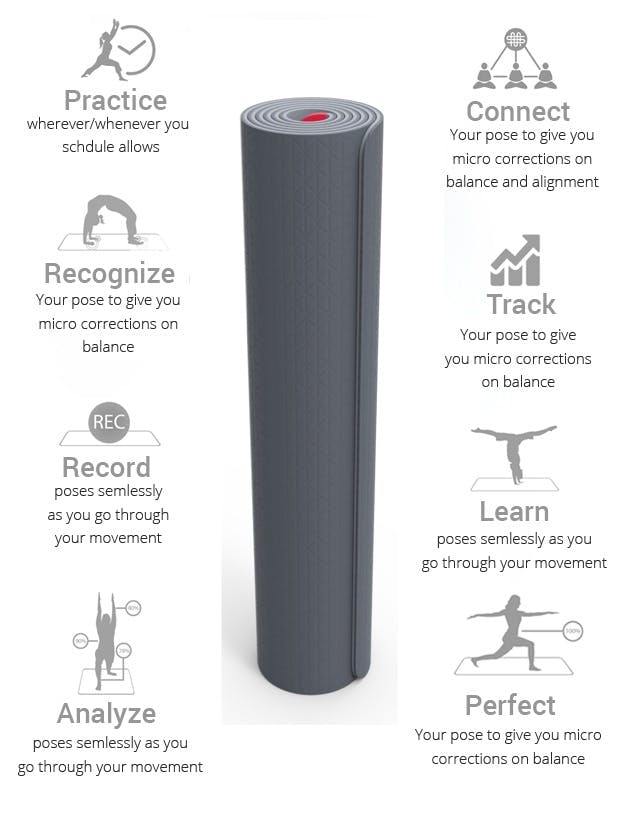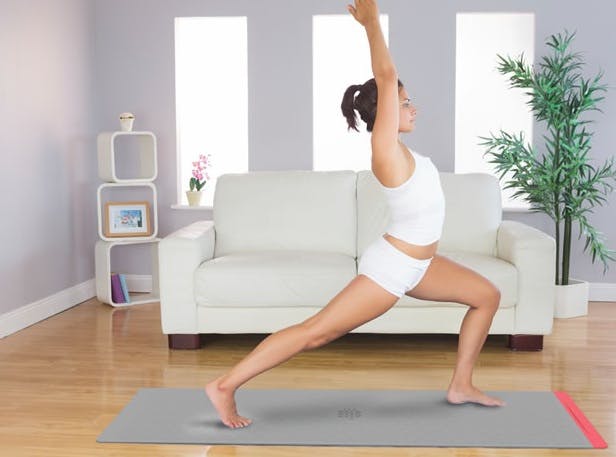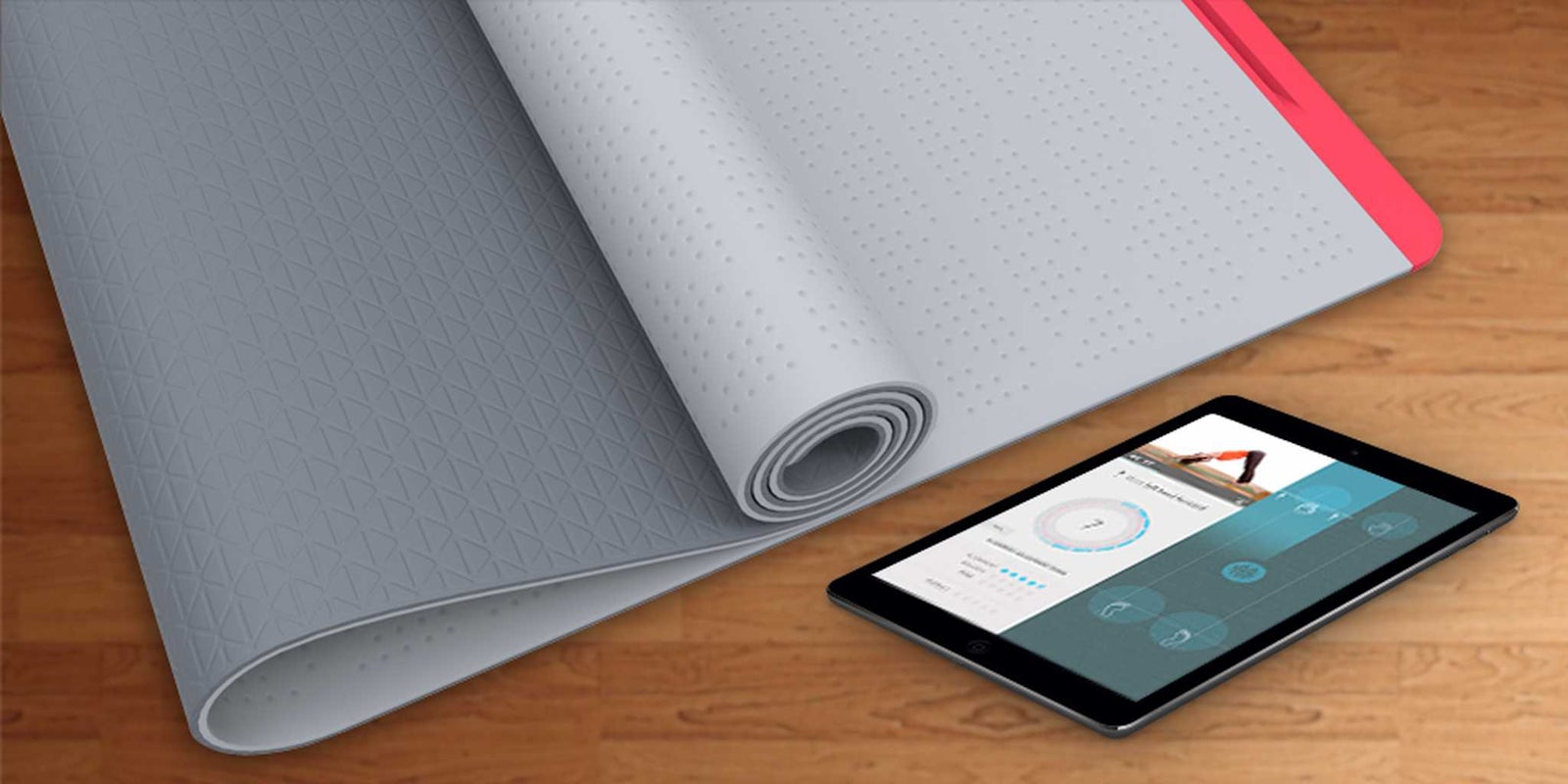Maybe your downward dog could use a little work. Or perhaps the angle on your back foot in warrior pose is just a little bit off. The solution to your yoga woes might be the SmartMat, the first Bluetooth connected yoga mat that tracks your movement and provides feedback to take your practice to the next level.
The creators of SmartMat launched an IndieGoGo campaign today to help fund this yogic enterprise, with an end goal of $110,000 raised. Perfecting your zen doesn’t come cheap: The mats are being sold at $297 each for “early contributors,” and will eventually retail for $447. They look and feel like a classic yoga mat, but at seven pounds contain all the artificial intelligence necessary for tracking your every move.
Though we haven’t had the opportunity to try a SmartMat IRL, we know how it works: You download the SmartMat app for iOS or Android on your tablet or smartphone, and it links up to the mat via Bluetooth. When you first activate the mat, the app will ask for some basic information like gender, height, and weight to help with the custom calibration. The app then provides guided instruction for a personal, private yoga practice, and reads students’ movement and offers audio/visual corrections throughout.
It’s also possible to roll up the mat and bring it to a class setting. In class you can either switch it into in-class-assist mode, which offers help visually or audio through headphones, or zen mode, which tracks progress for later review.
It seems like an unlikely pairing, sophisticated technology and yoga, and it’s natural to imagine a quiet room painted in earth tones with Pure Moods playing in the background. But for Neyma Jahan, one of SmartMat’s cofounders, the two have actually existed in harmony for some time now.
“It is a scaling question because up until 40 years ago, “yoga” was practiced on wool blankets or even on the ground and some people would say that the rubber sticky mats were a technology that could affect practice. It is a relative discussion,” Jahan told the Daily Dot. “Our blanket approach is that SmartMat and technology is a tool, just as a mat is a tool and some tools are useful for some people when they need them and it is up to the individual person to determine what and how much of each tool that they require.”
Despite the fact that the SmartMat was developed with help from a team of yoga teachers led by Amy Lombardo, a 15-year yoga vet, some other teachers are skeptical about the idea. And though they have yet to try it, the overall concept gives them pause.

“I can see how this might be a fun addition to an already experienced yoga practitioner’s practice, when they are traveling or can’t make it to class. However, I definitely do not think the mat is a substitute for in-class or private instruction,” New York-based yoga teacher Joanne Silver told the Daily Dot. Silver offers both private and group instruction, and she has a hard time imagining such a device fitting into either setting.
“A big part of the reason I practice yoga is to switch off from the distractions of the outside world which include, to a large extent, technology,” Silver continued. “Yoga is not just about ‘perfecting’ poses or being rated on one’s practice (which seems to be the premise of the SmartMat.) It is about connecting to the breath, creating space in the body and allowing the mind to slow down.”
Lisa Bermudez, another New York-based yoga teacher, agrees that this sounds like a product best-suited for upper-level yogis, and fears it could be dangerous for newcomers. She points out that although SmartMat tracks your alignment, it may not be able to read transitions between positions, where Bermudez says most injuries occur.
“It also takes the practice out of the yoga studio where I think a lot of amazing things happen,” Bermudez said. “Often, the ability to practice with each other is what helps us lift one another up. You can feel the energy in the room and this takes away from that.”
In SmartMat’s defense, this first line of product does seem mostly aimed at personal at-home use. However, Jahan says, “For Phase II in 2015 we will develop a teacher mode where a teacher could have 20 SmartMats in a class and watch the alignment of all of the students on their iPad allowing a blend of technology and personal touch.”
Though Silver and Bermudez are far from representative of the views of all yoga teachers, they were pretty much unanimous in their disdain for this idea.
“That just is a set up for breeding bad teachers,” Bermudez said. “One of the great things about taking class with a teacher is that they can see what’s going on without additional help from something electronic. It seems like it just adds an unnecessary third party to the equation, almost a way to disconnect as opposed to connect.”
And Silver feels the idea of checking students’ alignment on an iPad or other device totally contradicts the idea of a yoga group class.

“As a yoga teacher, it is my job to create a safe and comfortable environment for my students. It is also my job to be totally focused on the students in the room, watching their alignment and offering verbal and hands on assists throughout the class. Using an iPad, while teaching, goes against the whole premise of yoga, which is to be present.”
But in a blog post on the SmartMat website, Lombardo argues that it could be beneficial in a class setting. “As a teacher, I also know that people arrive at presencing in different ways. Some need visual cues that they can then imitate to get into their own body. Some need audio instruction. Others still need touch. In a class environment where I can’t always get around to support everyone fully in every posture, is it possible that the added guidance of SmartMat could help a student come into a deeper place of presence within themselves? Certainly.”
She adds that it could help yoga students take responsibility for their practice, remain focused in class and stay committed to achieving excellence and reaching benchmarks.
Skeptics need not fear the imminent threat of the SmartMat: The aforementioned “early adopters” won’t be receiving theirs until approximately July 2015. But we hope to get our hands on one before then to truly test the merits of something that is either totally superfluous or we totally can’t live without.
Photos via SmartMat
